Anna’s
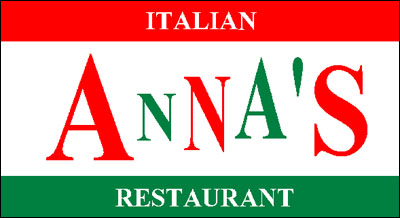
The best Italian restaurant I ever found, Zito’s, closed on Pico Boulevard (just west of Westwood) in 1969, the same year I graduated high school. Those two events may have been connected because Jo Anne Zito, daughter of the owners, was in my class and she graduated at the same time. With no evidence whatsoever, I’ve always thought that the Zito family was just waiting for Jo Anne to get her diploma before selling the restaurant and moving out of Los Angeles.
A new Italian restaurant named Anna’s moved into the building, at first keeping pretty much the same decor. I ate there once, resented the place for not being Zito’s, and decided not to go there again. I believe I had spaghetti and meatballs and wasn’t impressed. That’s what I usually order the first time I go to an Italian restaurant — spaghetti and meatballs. I figure if they can’t do that right, there’s no point in trying anything else.
A few years later, enough friends had told me how great Anna’s was that I decided to go give ’em another try. I was glad I did. I still wasn’t wild about their spaghetti but they had other things on the menu that were quite wonderful…especially the Cannelloni Napoletana. You got two large crepes stuffed with ground beef, cheese and the tiniest bit of spinach, all covered in a red sauce or a white sauce. It was one of the best dishes I ever had in a restaurant and it prevented me from sampling much else on the Anna’s menu. I mean, why bother? It wasn’t going to be any better than the Cannelloni Napoletana.
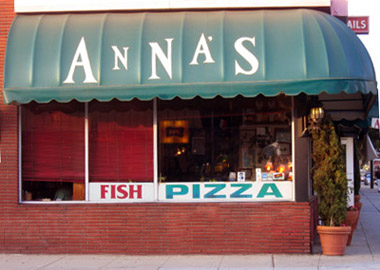
The other thing I liked best about Anna’s was walking up to it. It was on the corner of Pico and Kelton. On Kelton, there was a large vent from the kitchen and to walk past it was like being in a garlic sauna that could have melted Count Dracula on the spot. It was really an arresting sensation to get that burst of warm, garlic-infused air. Every time I took someone there, I made sure to steer them past the vent and to alert them to get ready. They all inhaled deeply and said, “Now, that’s how an Italian restaurant is supposed to smell!” I miss that as much as I miss the Cannelloni Napoletana.
Lastly, an honorable mention for the waiters. Anna’s had great ones. They were career professionals, not outta-work actors, and some were there 20+ years. They could be surly at times, especially with folks who’d peruse the menu for a half-hour then ask, “What’s good here?” But the service was first-rate and they really cared about you liking your food.
Anna’s was there 41 years…until June of 2010. The owners received an offer they couldn’t refuse from another restaurant that craved the real estate…so they sold. Good for them. Bad for lovers of good Italian cooking.
Little Joe’s
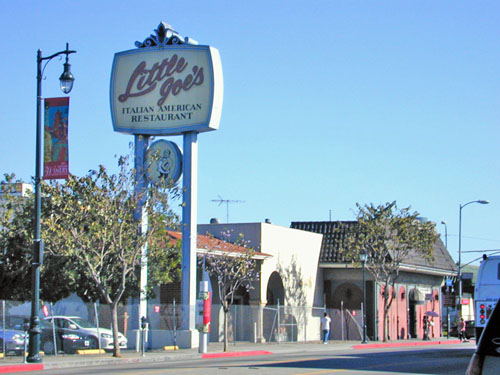
Little Joe’s was a very famous Italian restaurant in Los Angeles. And it was located just where you’d expect to find a very famous Italian restaurant: In the middle of Chinatown.
The institution started life in 1897 as the Italian-American Grocery Company at the corner of 5th and Hewitt Streets. One account says its founder-owner was Italian-born Charley Viotto. Another credits a man named John Nuccio, also an Italian immigrant. Around the turn of the century, the city’s Italian immigrant community relocated to the North Broadway area and the market followed in 1907, settling into the ground floor of a three-story hotel at Broadway and College. Eventually, the market turned into a restaurant and the hotel was torn down and replaced by a building that was just a restaurant — and a very nice one.
Along the way, the name was changed. After World War I, a number of Italian-American businesses changed their names to de-emphasize Italian heritage and some theorize that this prompted the restaurant to become Little Joe’s. In 1922, John Nuccio (who if he didn’t found the establishment seems to have acquired it by then) retired and sold out to his best friend, John Gadeschi. Nuccio’s son went to work there after serving in World War II and when he married Gadeschi’s daughter, control of Little Joe’s returned to the Nuccio family and remained there ever after.

In the forties, Little Joe’s became a favorite hangout of Hollywood stars. It is said that when W.C. Fields was staying at a nearby hospital to deal with alcohol abuse, he sometimes slipped out and hustled over to the bar at Little Joe’s for cocktails. When the Dodgers moved to Los Angeles in the fifties, Little Joe’s became a big hangout for fans of the team. Located not all that far from the stadium, it was a place to go before a game or — better still — after, when players were known to stop in. If the game was being televised, some people would decide to not hassle the parking and just watch it at the bar in Little Joe’s.
Over those decades, the neighborhood morphed into Chinatown. Little Joe’s was eventually the last major business for blocks around that wasn’t Asian in ownership and/or commerce. Business declined. It may have been the city’s oldest Italian restaurant but it was not its most convenient. As the building came to need major renovation, the Nuccio family decided it didn’t warrant the investment and Little Joe’s finally closed down in December of 1998. It was announced that the structure would be razed and an apartment and retail complex called the Chinatown Blossom Plaza would be built in its place at a cost of $162 million. But those plans fell through and the last time I was down there, the old Little Joe’s building was still standing, signage intact, fenced-off and looking pretty sad. Reportedly, a new shopping plaza is finally being erected there now.
I was only there once. For years, my family and I had heard of Little Joe’s. It was a very famous place to slurp pasta and everyone in my family was eager to try it. Everyone but me, that is. At the time, my favorite Italian restaurant was Zito’s which was much closer and where we never had a meal we didn’t love. So why travel all the way downtown to try a place which, at best, might be just as good? Good question. And the answer was that my Aunt Dot was on a “try new things” kick, lecturing us that there was something wrong with a person who stuck with the same old, same old. In 1969, on the day I graduated from high school, it was decided we’d follow the ceremony with a big family outing to some restaurant. Somehow, though it was my Graduation Day, I didn’t have a vote in the matter. We were going to Little Joe’s.
It was a long drive and a long wait for a table, and then the food failed to thrill us. When that happens in a place like that, you wonder if something’s wrong with you. After all, thousands and thousands of people have raved about the cuisine. It can’t be as bad as you think it is, can it? How could they be open all those years and have such a great reputation with mediocre cuisine? But they lasted a long time without, obviously, my business. Guess we just caught it on an off-night.
The Hungry Tiger

The Hungry Tiger was a chain of seafood restaurants around Southern California. At one point, there were forty-one of them, including one in Westwood Village, another one on Sepulveda near LAX, and yet another on La Brea just South of Hollywood Boulevard. Those were the ones I went to, and I’m not sure why because I never particularly liked the food at them and insofar as I could tell, neither did anyone else. The secret of their success seemed to be location, location, location. They were the only “nice” places to take a date or client in certain areas. For instance, if you picked up someone at the airport and drove south, the Hungry Tiger on Sepulveda was the first “decent” place to dine you encountered. They got a lot of post-funeral traffic from the nearby Hillside Memorial Park, too.
The chain was started in 1962 by, the story goes, a group of former Flying Tigers’ combat pilots. Some of the first outlets resembled hangars more than restaurants and all were decorated with photos of old planes and aviators. I’m not sure many patrons understood the connection.
In the early eighties, business fell off substantially, apparently due to an influx of strong competitors into the marketplace. The Hungry Tiger chain needed to remodel and upgrade but lacked the funds to do this so in 1985, a new management team was brought in, some of the less profitable outlets were closed and a general relaunch was attempted. It failed to turn around public abandonment of the eateries so in the years following, most of them closed and a few went independent. There are still Hungry Tiger restaurants around but not as part of a large chain.
The last time I was in one, it was the one in Westwood. This would have been around 1980. My date and I were going to a play at the Westwood Playhouse and with parking being as difficult and expensive as it was up there, it seemed logical to dine at the Hungry Tiger that was in the same block as the theater. We could park once for both, get validated at the restaurant and…well, you get the idea.
We both ordered the broiled shrimp and when it came, it turned out to be the kind served in the shell…not my favorite way of having shrimp. When they serve it that way, you always seem to spend forever digging the meat out and there isn’t very much of it. These had almost none. My lady friend and I were amazed at how little edible shrimp flesh you got in a serving of Hungry Tiger broiled shrimp. It was barely one mouthful. We mentioned this to our server who called over a manager who basically told us, “That’s our broiled shrimp. If you didn’t get enough to eat, order something else and pay for an additional entree, heh heh.” Those weren’t the precise words he used but they were close. There was definitely no concern that we weren’t happy with our meals. We would have done what he suggested if there had been time before the play, except that (of course) we would have done it at another restaurant.
After the play, we decided to go somewhere and actually eat, rationalizing that at least the hefty tab I’d played at the Hungry Tiger had gotten us our parking at a discount. It turned out that despite the posted signs, the lot no longer honored Hungry Tiger validations and I had to pay full price to get out. The next day, I wasted about an hour calling the restaurant and the corporate offices of Hungry Tiger to complain. The attitude I encountered was along the lines of “If you don’t like it, eat somewhere else.” Thereafter, I did…and wasn’t surprised that so many other people did, as well. Beware any business that names itself after a voracious predator.
Victoria Station
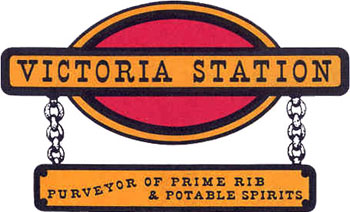
At last report, there was only one outlet remaining of this once-proud chain…in Salem, MA stands the last of the railroad-themed restaurants known as Victoria Station. The first of them, which was opened in San Francisco in the late sixties, was an outgrowth of a graduate project by three students at Cornell University Hotel School, Bob Freeman, Peter Lee and Dick Bradley. Their new eatery, colorfully decorated with pieces of old trains and London-style phone booths, caught on big and soon there were approximately a hundred of them in existence, including the one I frequented. It was at Universal Studios, not far from where the famous studio tour commenced. The Victoria Station there was huge and it was said to be one of the top-grossing restaurants in America. Based on the crowds, I wasn’t surprised to hear that.
The specialty of a Victoria Station was prime rib but you could also get a steak or ribs or roast chicken or Shrimp Victoria, which was like scampi but without vast amounts of garlic. The food was all pretty good but I recall some long, long waits for a table and if you weren’t going on the Universal Tour (and I never was) the parking could be quite inconvenient. It was a place I’d never choose to dine but business associates kept asking me to meet them there for meals, and its banquet room housed many a party I felt I had to attend.
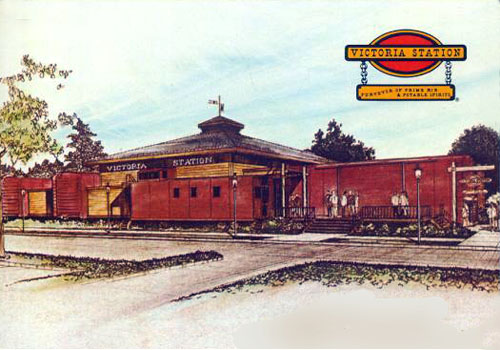
One nice feature of that Victoria Station (and perhaps others) was the employee morale. The folks who worked there liked working there, and the chain was often written up as one of the more benevolent employers in the country, offering its workers stock options and other unusual benefits. In keeping with the railroad theme, Johnny Cash did their commercials.
So what happened to this successful chain? Its one-time Director of Marketing, Tom Blake, authored a whole book on the subject that charged arrogance and mismanagement at the company’s highest levels destroyed the business. News reports at the time seemed to substantiate his view, which was a shame. All the folks who worked there seemed so happy to be working there.
Tail o’ the Pup
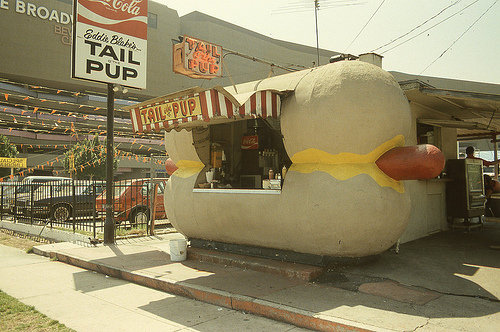
One of the most famous structures in Los Angeles — it seemed to get in every montage of city sights — was the hot dog stand that looked like a giant hot dog. Tail o’ the Pup was built in 1946 and opened near the corner of La Cienega and Beverly Boulevards with a real, star-studded Hollywood-type gala. It was built by a man named Milton Black and its original owners were the dance team of Veloz and Yolanda. It was a way of investing their show biz earnings in something more stable. The dog, by the way, was 17 feet long and was basically a front piece that fit onto a more conventional kitchen trailer.
Around 1971, a man named Eddie Blake bought it and thereafter operated the stand with the help of his son, Dennis. Dennis eventually took over the family business and the Blakes did a pretty good job. Obviously, the novelty attracted customers but the quality of the dogs kept them coming back.
All was well until 1985 when the landlord decided to build a luxury hotel on that corner. The Blakes moved their big dog over to San Vicente. A few years later, an expansion of facilities at the nearby Cedars-Sinai Hospital displaced them again. Unable to find a suitable new location, the Blakes moved the giant frankfurter into a storage facility as they dickered for a new address. At last report, they’re still looking and they say that when they do find the right plot of ground, the big wienie will come out of storage and they’ll slap on a new coat of paint — or mustard or whatever — and set up shop.
I’ll bet they do it. The stand is too famous not to be part of the L.A. landscape once again. When they manage it, I’ll amend this item…but right now, it’s an L.A. restaurant that ain’t there no more.
Tail o’ the Cock
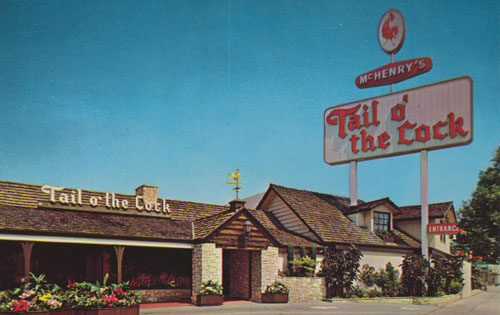
The photo above is of the Tail o’ the Cock at 44 S. La Cienega Boulevard, aka “Restaurant Row.” There was another at 12950 Ventura Boulevard — both popular dinner joints famous for their America menus (steak, prime rib, etc.) and bar scene. The Tail o’ the Cock claimed to be the first place in Los Angeles to serve Margaritas and it may well have been, I don’t know.
As one might gather from the name, the big selling point at Tail o’ the Cock wasn’t the food so much as the cocktails. It was a popular place for people to meet for drinks, especially late in the afternoon. An awful lot of Hollywood deals were consummated there over martinis. It was where a voice actress named June Foray met with two animation producers — Jay Ward and Bill Scott — and they told her they wanted her to play a new character named Rocky the Flying Squirrel. And there were probably less important roles cast there involving big Academy Award productions.
I ate once at the one on Ventura. I recall the food being satisfactory but not much more. I recall the room being somewhat dark and depressing. I recall the service being quite friendly and efficient. It was the kind of place where the servers and the bartenders had been there for a decade or more and had no intention of going anywhere else. Then the two places closed down, one after the other.
Owner-founder Sheldon A. (Mac) McHenry sold the one on La Cienega in 1982 and it closed in 1985. There’s an office building there now though it does have an Indian restaurant on the ground floor.
The one in the Valley closed a few days after New Year’s, 1987. It was razed and a shopping mall was built in its place. A lot of people still remember the two restaurants fondly.
Chasen’s
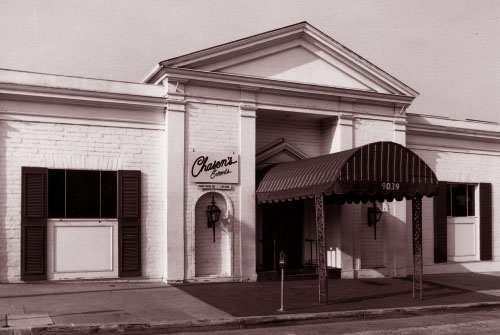
The legendary dining place of the stars was over at the corner of Beverly Boulevard and Doheny in a building that is now a Bristol Farms market. Perhaps, once upon a time, the food was the star attraction but by the time I began going there from time to time in the eighties, the star attraction was the star attraction…being able to say, “Gregory Peck was dining right across the room.” My own most memorable experience there (recounted here) was a meal with Jimmy Stewart. I also lunched there the last day it was open and Nancy Reagan was in the next booth.
For this, one paid about twice the price of similar food almost anywhere else. I never found the meals worth the price and the service, if you weren’t a regular or famous, could be downright curt. I observed the striking contrast when I dined there with Mr. Stewart as opposed to someone who wasn’t famous. I didn’t expect to be treated as courteously when not with Mr. Stewart as with, but the difference was greater than it had to be. The Stewart-less time, we were seated at a table the size of a Cheerios box and the waiter had the attitude of, “Why do I have to wait on you?” with the “you” dripping in dismissal. It must not have been typical of the hospitality there or the place would have closed long before it did.
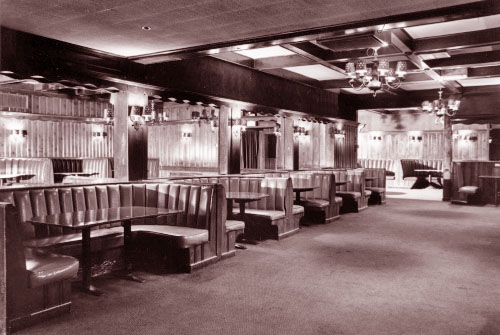
When it did finally shut down, there were many “end of an era” articles and tributes, all recounting the glory days when you might see Bogart pop in for a bowl of chili. No doubt the fact that it ceased to be “The Place Where the Stars Eat” contributed to its demise but I also think the price/value ratio and catering to the famous had an awful lot to do with it. If you wanted to overpay for London Broil, there were better places to do that. Especially if they didn’t know who you were.
Wan-Q

A Yellow Pages ad
Wan-Q was a terrific Chinese restaurant located on Pico Boulevard, just east of Robertson, in the building that now houses another terrific Chinese restaurant called Fu’s Palace. Unlike Wan-Q, Fu’s Palace is not a dark place full of tropical decor and little streams and waterfalls that run through the room. I took some of my first dates to Wan-Q because it seemed to be that kind of place, but its main clientele was local Jewish families.
If you were Jewish in the sixties in Los Angeles, it seemed almost mandatory that your family have a favorite Chinese restaurant. In that area, loyalties were divided between Wan-Q and a place a few blocks east on Pico named Kowloon, which is also now long gone. There were other Chinese eateries along that stretch of Pico but somehow, even local newspaper reporters sensed the great Wan-Q/Kowloon rivalry and wrote of it. We were Wan-Q people but once, just to be fair-minded, we dined at Kowloon and confirmed our hunch that it was inferior.
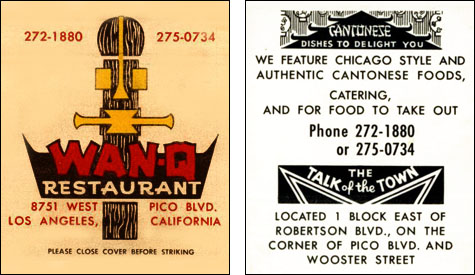
The waiters at Wan-Q were great and they really did fit the Great Chinese Waiter Stereotype of all looking alike…but you could tell them apart by the loud Hawaiian-style shirts they wore. There was one who thought the funniest thing in the world was to ask, when a family ordered something with pork in it, “Are you Joosh?” That was how he pronounced “Jewish.”
Wan-Q was the first place I ever had Chinese Food and to this day, my concept of the right way to prepare certain dishes is rooted in how they were prepared there. As I said, I took dates there. One time, I took a lady named Karen to Wan-Q on our way down to the Music Center downtown to see Art Carney star in a production of Prisoner of Second Avenue. For some reason, we drastically over-ordered. Karen and I stuffed ourselves to capacity and there was still enough food on our table to feed a family of four. The waiter offered to box it all up but we decided it wouldn’t keep in the car ’til after the play. We were sitting there, feeling it was a shame to toss out all that grub when I noticed my parents walking in with my Aunt Dot.
They were seated on the other side of the restaurant and didn’t see us, which was fine with me. My folks and Aunt would thought it was “cute” to see me there with my date…and if you’re 18 and out on a date, the last thing you want is to be cute the way you’re cute to your parents. So we figured out how we could get out of Wan-Q without being spotted but before we left, I told the waiter, “Box all this food up and after we’re gone, give it to the people at that table and ask them to take it home for Mark.” When I got home that night, my mother laughed and said, “If you’re hungry, I could heat up some of your dinner for you!”
It was a sad day when Wan-Q went out of business, not only for my family and for the proprietors of the restaurant but also for whoever owned that building. It proceeded to house a veritable United Nations of different failed restaurants (Mexican, Polynesian, Jamaican, etc.) before finally, after a decade or so, reverting to its birthright as a Chinese eatery. I used to drive by and marvel at how each new tenant adapted some of the exterior decor of the previous resident. The odd roof that’s there now and the split telephone poles nailed to the sides of the building are, I believe, leftovers from when it was a Caribbean-themed eatery called the Sugar Shack. They didn’t make a lot of sense then, either.
The Dog House
The Dog Houses comprised a chain of very small restaurants around L.A., often on a piece of land that also held a large car wash. I’m going to guess that was the idea. Someone said, “Hey, let’s design a little restaurant that can fit in a spot that doesn’t seem big enough for a restaurant and where people have to wait around for their car to be washed.” And then someone else said, “Uh, like a hot dog stand?” And the first person said, “Kind of…but let’s make it a little more upscale so we’ll get the business of folks who think they’re too good to eat at a hot dog stand.”
At least, that seemed to be the premise, though I don’t think the one in the above photo was near a car wash. It did however display uncommon courage by daring to sell hot dogs around the corner from Pink’s. As you can see, a Dog House was a small building that vaguely resembled a dog house…and I vaguely recall some had stools that looked like hydrants. You could dine inside at the counter or outside in a small porch area with tables. Either one was cramped but inside, it was worse.
Outside, they often had waitresses and menus, and the selection was obviously limited by the size of their tiny kitchens. Basically, it was burgers, dogs and a few sandwiches and salads, and I think some of them also served breakfast. The food was not wonderful but I think it was a case of the cute decor making you expect something better than your basic hot dog/burger stand.
Scot’s
Scot’s was a small chain of McDonald’s knock-offs and we used to go to the one located on the Southwest corner of Pico Boulevard and Westwood — land that now contains a Barnes & Noble. Their mascot, who I believe only existed as one piece of line art, was a sexy lady wearing kilts and doing a dance. They had a huge drawing of her towering over the main building.
One suspects the lady and the chain’s name was because someone thought, “Hmm…maybe people go to McDonald’s because they think it’s Scottish.” Or perhaps the thought process was that people weren’t that familiar yet with McDonald’s — this was before that company’s big advertising blitz — and that they’d go to Scot’s, thinking it was the place they had in mind. Either way, there was nothing else at Scot’s that had anything to do with Scotland unless it was that the food was cheap and there’s a stereotype of Scottish folks as excessively frugal.
The menu was pretty much what McDonald’s then had plus a few extra items such as pizza. When they finally closed down, the structure at Pico and Westwood went through a year or three of name and ownership changes. For a while, it was Pride’s, then something else, then something else. They finally cleared the land and built a Lone Ranger Restaurant there. It didn’t last long, either.
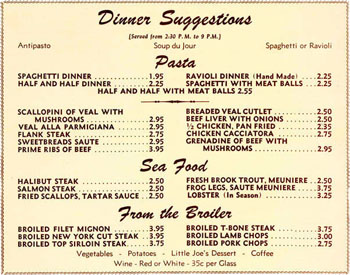
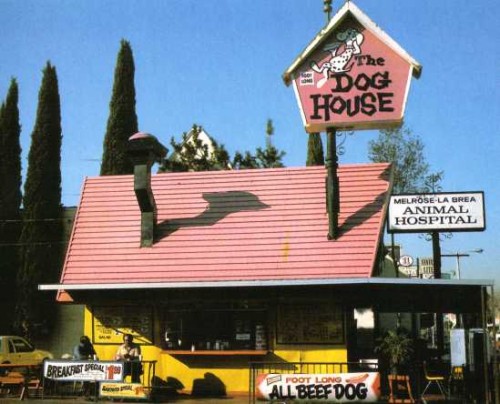






Recent Comments